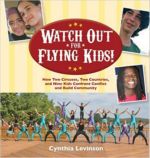
Watch Out for Flying Kids!
Written by Cynthia Levinson
Peachtree, 2015, 216 pp.
ISBN 9781561458219
Circus is based on trust and overcoming fear and on making people laugh. Those are all in short supply in this part of the world. (p.23)
The search for understanding among cultures to resolve conflict is not a new endeavor and yet how this is approached has taken on new possibilities over time. Building a global community requires insight about the “other” and this insight is not always available nor are the opportunities for young people to interact with those of other cultures and nationalities. This book reflects the vision of change that began with individuals from St. Louis and Galilee, communities where diversity flourishes in different ways. Youth Social Circus, an arts education movement, is the venue that engaged these young people through the tumbling and gymnastic arts of the circus. The book focuses on nine young people from two countries who confront physical challenges, racism, animosity, and trust within a context that requires community and identity.
St. Louis is the home of Circus Harmony or “the Arches,” a group reflective of children who range from urban St. Louis to suburban families with greater life opportunities—children of different cultures. Young people from Galilee, both Palestinian and Israeli, live within an ongoing prejudicial and conflict-laden environment. This book focuses on the coming together of these two groups, each having overcome personal prejudice in transforming ways, as they extend their loyalty and trust to a global population far removed from their daily lives. Collaboration and community building is a necessity within the circus world where they perform. The hope of this movement is well expressed by Marc Rosenstein, a former leader of the Galilee Circus:
Circus will not bring peace to the Middle East. But it can help to make dialogue possible by reducing fears, lowering barriers, and building trust. It can provide a model of a shared loyalty that transcends ethnic identities. It can teach the art of taking risks for the common good. It can demonstrate, to a wide audience, that what appears to be impossible is indeed possible. None of these may be sufficient to bring about the requisite social change, but without them, no change is possible. (everydaycircus.net)
With stories of individuals who bring to life this experience for readers of all ages, Levinson has created an informational text that is a rich source of different perspectives highlighting the struggles that have existed for each of the groups across time. Each youth’s search for identity is evident in the autobiographical accounts of growing up and later performing. These young artists admit to their challenges of getting to know others and yet a strong sense of community and collaboration is evident in their own perceptions of the circus venue.
The author begins the book with a pronunciation guide to names of people and places that are the focus, signaling the importance of connecting name to identity. Side bars hold essential information about the young circus performers as well as about historic and cultural events that highlight the cultural experiences of these youth. Brightly colored photographs depict individuals as well as the circus in acts of tumbling, gymnastics, juggling, and other feats that reflect hours of practice and perfection of the circus arts.
Learning about this particular unique approach to a peaceful existence creates an inspiring and hopeful story. The information shared in context regarding the struggles within urban St. Louis and the ongoing challenges in Galilee make reading this book even more fulfilling. The reader finishes the book informed, hopeful, and inspired by the stories. Hope for peaceful change in society lies, perhaps, in the youth of today who are given opportunities to build relationships with others in their local communities as well as the larger global community.
This book would easily pair with other works by Levinson such as We’ve Got a Job (2015) since both look at children taking a stand and a developing their voice within society. The notion of creating unlikely friendships through experiences of trust, and both personal attitudes and professional performance, is found in this book as well as in Sharing Our Homeland: Palestinian and Jewish Children at Summer Peace Camp (Trish Marx, 2010). Media might also be employed using numerous YouTube clips and the Galilee Circus website. Other/ resources are easily located on the Internet and can be used to put into motion the focus of this book.
Cynthia Levinson wrote this book over a four year period that included traveling to Israel and the United States cities of St. Louis, Chicago, Saratoga, and Sarasota. She carried out 120 hours of interviews in three languages that involved two translators. Levinson relishes in nonfiction to include writing articles for magazines for youth as well as books. More information on Cynthia Levinson can be found at her website.
Janelle Mathis, University of North Texas
WOW Review, Volume VIII, Issue 2 by Worlds of Words is licensed under a Creative Commons Attribution-NonCommercial-ShareAlike 4.0 International License. Based on work at https://wowlit.org/on-line-publications/review/viii-2/
